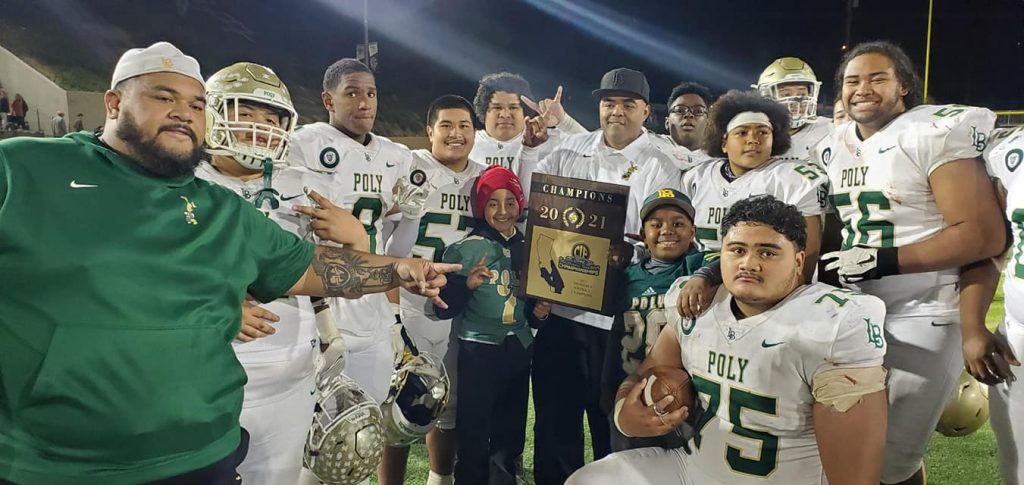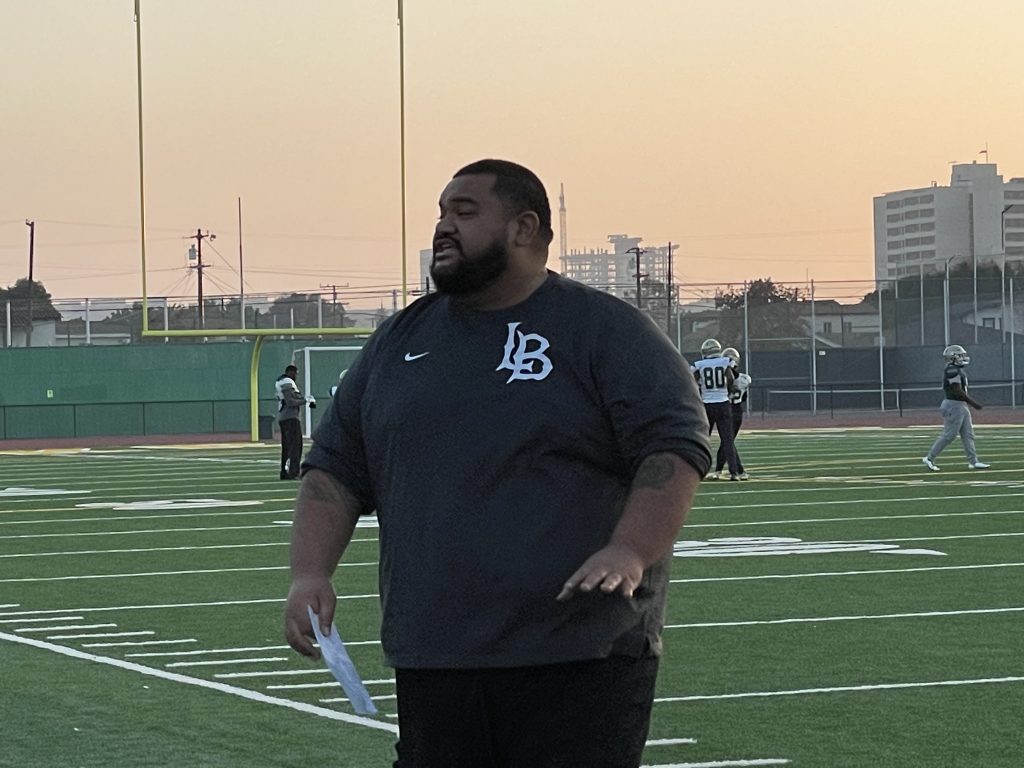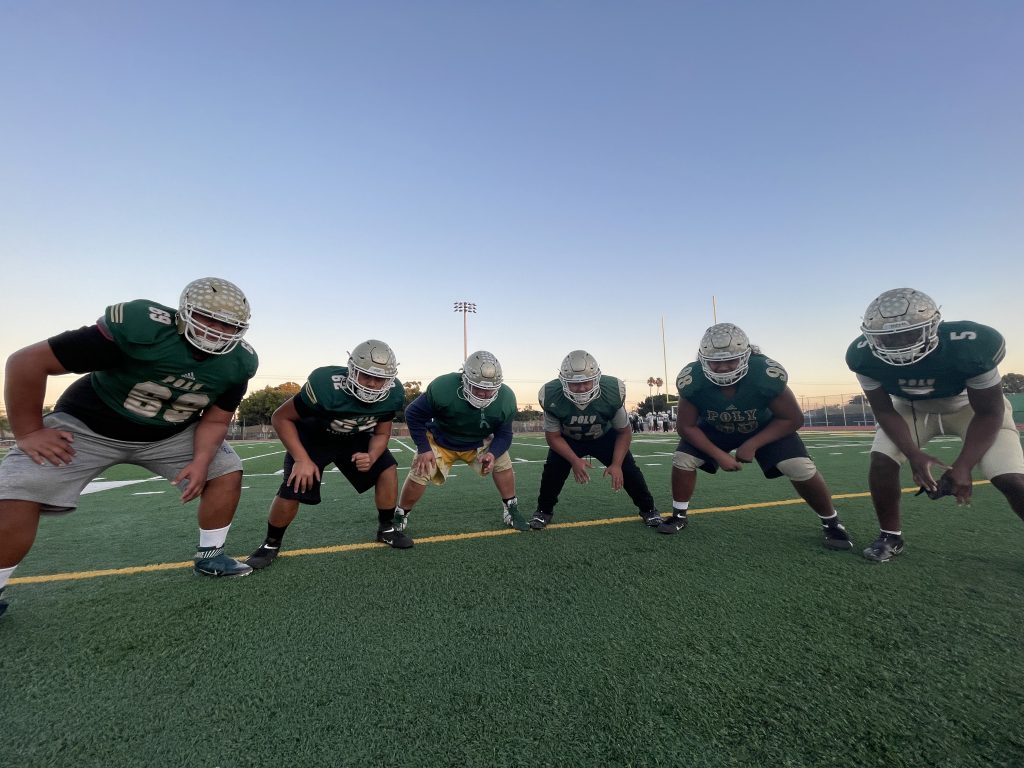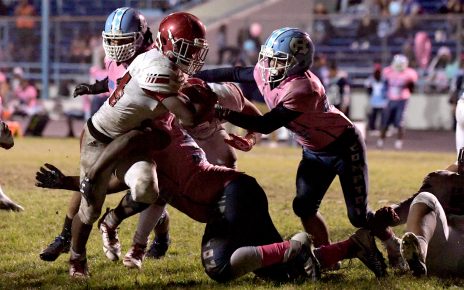As the celebration raged on around them, Long Beach Poly’s offensive linemen stood with their hands on their knees, soaking it in. There was confetti in the air, fans on the field, and an ice bucket that had been dumped on Poly coach Stephen Barbee laying on the ground nearby. And there were crimson splotches of blood on the white jerseys of Wendell “Wowo” Moe, Tyson Ruffins, Nathan Samoa, Jeremiah Filipo, Ropati “Ola” Eneliko, and Malik Brown.
The six players who powered Poly’s championship win were ecstatic. The Jackrabbits had just defeated St. Francis 38-7 in the CIF-SS Division 4 championship, claiming Poly’s first title since 2012 and 20th title ever. The line helped power them to 388 rushing yards, collecting pancake blocks and bloodstains along the way.
“Who’s blood is that?” someone asked Ruffins.
“I dunno, someone else’s,” he said, a wide grin on his face.
The players
“They’re the difference, and they’ve been the difference this whole season as we’ve gotten better,” said Barbee at practice this week. “Whether we’re running for 300 yards or passing for 300--none of that happened without them. They’re the rock of this team.”
The season didn’t start out that way. In Poly’s season opener, against Serra, the Jackrabbits rushed for just 120 yards, giving up 10 tackles for a loss and three sacks. The group stuck together, and line coaches Marcus Falanai and Jermaine Jackson put in extra work with them both on the field and in the film room. The improvement from that first game to their dominant effort in the championship is astounding.

Jackson said the improvement didn’t come from any magic trick or secret, but from old-fashioned hard work.
“This was a group that graduated some two and three-year mainstays from last year,” said Jackson. “We only have one senior in the entire offensive line group so we had to put it together quickly--and they put extra work in together, before practice, after practice.”
At left tackle is Ruffins, a junior to build around for next year--tall and athletic, Ruffins was dominant during the offseason at camps against higher-rated players. At 6-3, 305 pounds, he holds scholarship offers from Morgan State and Idaho State.
Samoa plays at left guard, and was the team’s center during the Spring season. That experience gave him confidence and a great knowledge of the entire scheme coming into this, his junior year. Filipo has been playing at center this year, an impressive role for a sophomore but one he’s stepped into more than capably.
The player who gets the most attention is at right guard: Moe, the 6-3, 330 pound monster senior who has been an absolute terror when he pulls, plowing a huge lane for running backs Devin Samples and Joshua “Noodles” Cason. In one play against St. Francis, Moe lifted a defensive lineman off his feet with perfect technique, driving him back and into a linebacker. Compton coach Calvin Bryant called Moe the best lineman he’d seen in the Moore League since Poly had Jurrell Casey, the five-time Pro Bowler who recently retired after a decorated NFL career.
At right tackle is perhaps the most impressive player of the bunch in Eneliko, better known by his nickname “Ola.” Although Eneliko is undersized at right tackle--and truthfully would be undersized at many positions--he’s started every game at RT, and has probably the best motor and fighting spirit of anyone in the group. In the win over St. Francis, he was routinely five to ten yards downfield driving defenders back on their butts. The Jackrabbits also have a Swiss Army knife in tight end Malik Brown, who’s been dominant in the run game as well. The 6-3, 220 pound senior has been drawing scholarship interest from Pac-12 programs who’ve been out to see Poly practice this week.
The line is a tight-knit group that spends practices pushing each other, and also cracking jokes in between reps. Their chemistry together is hard-earned and obvious--and their excitement about getting to help decide the championship game was palpable.
“I love it when the game’s on our backs, it shows how important the O-Line is,” said Moe. “Usually the spotlight’s not on us. But in a game like that it comes down to us.”
“Not to be disrespectful to anyone else on the team but I feel like our O-Line puts in more work than anyone else, extra work on bags and sleds, it felt great to see us get to shine like that,” said Ruffins.
The coaches
The guys who’ve helped scheme up and motor the improvement in the group this year are Jackson and Falanai. Jackson is a Schurr alum who played at Oregon State and who left Windward for Poly on a whim when he saw the job posted on the CIF-SS website, hoping to take the next step up in his career and coach at a powerhouse high school.
Falanai is an alum and a member of the 2007 CIF-SS championship team at Poly. He is also the next in a long line of Polynesian coaches and mentors at the school--an important part of Poly’s culture as well as its athletic history dating back more than half a century.
“Talking to Don Norford and Merle Cole when they’ve both been out here, they’re telling me that I’m part of the tradition now, and that’s crazy to me,” said Falanai. “I was on the sideline when I was seven or eight years old watching them, seeking knowledge from them. To have them tell me that I’m here for the right reasons--they’re like godfathers around here, that means a lot to me.”

Falanai was one of the first assistants to apply when Barbee took over the program, and he’s been coaching with Poly since then.
“The previous coach said he wanted to run the program like a business, and I wasn’t a fan of that,” he said. “Coach Barbee the first thing he said was that he understood this program is a family. He told me about how he wanted to model the program that way, and there was a sincerity in him talking about the community and the kids here, not just about football. The kids and the community were the priority--and that’s my priority too. So I told him I’d come coach with him and I’d be here till the m----------g wheels fall off.”
That family-first approach has obviously resonated with the Long Beach community in a big way, especially with the Polynesian community. Where there were just four Polynesian players in the program when Barbee took over four years ago, there are close to 60 across all three levels now. Falanai said that’s not a surprise to him at all.
“You cannot BS the Polynesians, because everyone knows everyone in our community,” he said. “So when you’re genuine and you really care, everyone knows that. When you’re for the kids, everyone knows you’re for the kids. When you’re having team barbeques and making sure everyone has enough food and you’re hosting potlucks, people know that’s genuinely from love and from our culture.”
The brotherhood
It’s not a surprise that Poly’s entire starting offensive line this year is Polynesian, as is most of its defensive line and most of the backups for both units. That’s long been a part of the on-field success for the program, dating back to the 1960s. But players and coaches on the team emphasized that the benefits of having Polynesian culture back at 1600 Atlantic extend far beyond the football field.

“They’re the heartbeat of this team,” said Barbee. “That’s not just football, that’s the social context of the team. They handle so many things, they defuse situations that could arise between teammates. They’re all very family-oriented and it creates that type of atmosphere within the team and on our campus.”
Ruffins said that the offensive line basically spends its entire day together--in class, at practice, and playing Call of Duty or Madden after practice.
“The whole team is my family, but we’re especially closely knitted together, we basically see each other every second of the day,” he said.
“It’s like a family,” said Moe. “Having a bunch of Polys on the team, there’s no hate, it’s always love when it comes to our culture.”
That love has brought all kinds of benefits to the Poly football team--on and off the field. It’s also brought a few rare problems, including a skyrocketing Oxi Clean bill to get all the red cleaned off of those white jerseys after the championship. That’s not a cost that anyone in the program has complained about, of course--what’s a few bloodstains between brothers?





